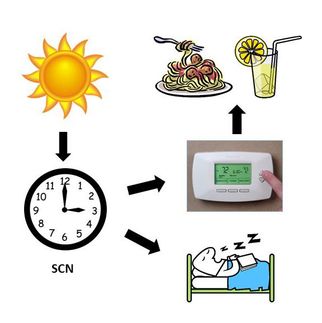Dual internal clocks keep plant defenses on schedule
Advertisement
Time management isn’t just important for busy people - it’s critical for plants, too. A Duke University study shows how two biological clocks work together to help plants deal with intermittent demands such as fungal infections, while maintaining an already-packed daily schedule of activities like growth.
The researchers also identified a gene that senses disturbances in the “tick-tock” of one clock, and causes the other clock to tighten its timetable. Their work appears in Nature.
From daily sleep/wake cycles and fluctuations in body temperature in animals to growth and photosynthesis in plants, all living things have an internal clock that enables them to coordinate their behavior and physiology with the 24-hour cycle of day and night.
Plant defenses are no exception. In a previous study, Duke University biologist Xinnian Dong and colleagues discovered that plants fend off potential fungal infections by boosting their defenses in the morning, when many fungi are likely to release their spores and launch an attack.
These and other daily rhythms are thought to be driven by oscillations in the activation of “morning genes” and “evening genes.” Proteins made by the morning genes suppress the evening genes at the beginning of the day, but as the proteins start to build up within the cell they eventually turn themselves off. The subsequent drop in morning protein levels near the end of the day in turn activates the “evening” genes, creating a continuous 24-hour loop.
Organisms from humans to algae also have another clock that doesn’t rely on rhythmic gene expression to keep time, but instead uses the rise and fall of the reactive oxygen molecules that are formed as natural byproducts of metabolism.
Researchers have known about both timekeeping mechanisms for several years, but haven’t figured out how the two clocks are linked, or why organisms have both.
“The basic question is: why do you need two clocks in one ‘room’?” Dong said.
For their experiments, Duke co-authors Mian Zhou and Wei Wang treated Arabidopsis thaliana plants with salicylic acid, an aspirin-like compound that plants use to fight infection.
The salicylic acid treatment disrupted the normal daily fluctuation of reactive oxygen molecules in the plants’ cells. But the researchers were surprised to find that the plants’ circadian clock genes only made more proteins with the same regular rhythm.
“They more or less kept the timing as it was before,” said Duke co-author Nicolas Buchler, who is an assistant professor of biology and physics.
Buchler and his graduate student Sargis Karapetyan then used a mathematical model to explain this phenomenon. They found that rather than run fast or slow, plants treated with salicylic acid activated both their ”morning” clock genes and their “evening” clock genes more strongly.
The researchers also identified a gene called NPR1 that links the two clocks, allowing them to work together. Like a molecular thermostat, NPR1 senses changes in the “tick-tock” of the plants’ reactive oxygen species clock, and responds by turning up both the “morning” and the “evening” genes in the other clock.
The end result was that the plants’ immune systems were even more prepared for fungal attack in the morning but more susceptible to infection at night -- presumably to minimize interference between pathogen defense and growth, which mainly occurs in the pre-dawn hours.
“Plant growth suffers if plants activate defense at the wrong time,” Dong said.
Their next step is to inactivate the NPR1 thermostat and see how plant rhythms respond.
“Sometimes having too rigid a schedule is bad,” Dong said. “But the busier you are, the more important it is to stay on schedule and coordinate competing tasks for different times of day,” Dong said.
Original publication
M. Zhou et al.; "Redox Rhythm Reinforces the Circadian Clock to Gate Immune Response," Nature 2015.




























































